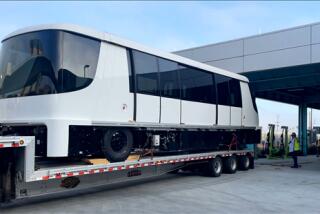International Technology : Hong Kong’s People Moving Into Future : In a project reminiscent of the Jetsons, a half-mile of elaborate escalators will transport commuters above busy streets.
- Share via
HONG KONG — Old, narrow Hong Kong roads originally built for the use of sedan chairs are to be transformed into a space-age people mover reminiscent of the Jetsons cartoon under a project nearing completion in one of the colony’s oldest sections.
Billed as the longest system of its type in the world and the first meant exclusively to transport commuters, the $27-million project consists of a half-mile-long network of outdoor escalators, moving walkways and footbridges covered by a plastic canopy. When opened in early October, it is to link the inhabitants of high-rise apartment buildings in the trendy Mid-Levels area to the towering office structures of the Central business and banking district situated alongside Hong Kong’s harbor.
The trip from one end of the people mover to the other is supposed to take about 20 minutes.
“I walk down to work almost every morning because there aren’t many taxis available if you’re not on the street trying to wave one down by 8:15,” said Tom Vaizey, a lawyer with Johnson Stokes & Master who plans to commute by the new system.
“Given that Hong Kong’s temperatures are usually above 30 degrees Celsius (86 degrees Fahrenheit) most of the year, walking can be miserable. Once the escalator is built, it is going to make my life a great deal easier.”
With an estimated population of more than 56,000 residents, the Mid-Levels tend to attract a large number of expatriates whose companies are willing to put them up in apartments that typically rent for the equivalent of $5,000 to $10,000 a month.
“The Mid-Levels is a hilly, densely populated area with virtually no room to widen the roads,” which are severely congested, said C. K. Chan, a Hong Kong government Highways Department consulting engineer on the project. “I think this area is most suitable for this type of transportation system because it’s extremely close to Central and therefore more cost-effective.”
Chan said the people mover will be able to carry 26,000 to 30,000 commuters per day.
“The system will start moving downhill when commuters start going to work from 6 in the morning until 10, then reverse direction and move uphill to transport commuters from Central to their homes until 10 at night,” he explained. “There are 23 points of exit, which includes all major road crossings.”
The escalator was originally scheduled for an early 1993 completion date but has been delayed until October, mainly because unmapped underground cables and pipes had to be rerouted. Engineers on the site said they were not surprised by the difficulties, given the location of the project in one of Hong Kong’s oldest districts.
“Due to the restricted space available and the need to maintain emergency access, it was only possible to fit in one escalator in the available width,” said Richard Garrett, director of Maunsell Consultants Asia, the company that designed the transportation system.
C.N.I.M. Hong Kong is the local subsidiary of the French company supplying the escalators. Edward Chow, commercial manager of the subsidiary, said the advantages of the project are that it is free of charge to the user, it cuts down on traffic and it runs on electricity so it’s environmentally friendly.
The system will be patrolled on foot by transport attendants and monitored by closed-circuit television, which is hooked up to Hong Kong’s Police Regional Command and Control Center, Chan said. There is a walkway alongside the escalator in case of an emergency or breakdown, he added.
While it may be popular with commuters, however, the system already has its critics among some merchants and architects.
“I think the structure is essentially a functional design,” said James Gibson, managing partner of architects Denton Corker Marshall, a company that was consulted by the Hong Kong government in the preliminary design stage of the project. “I wouldn’t say it’s one which has put sufficient emphasis on appearance.”
Local architect Tao Ho agrees. “Practically speaking, I think it is a very good idea,” Ho said. “But it should have been better integrated with its surroundings.”
Some business leaders in the area say customers have been put off by the pollution and noise caused by the construction. Stanley Choi, manager of the Wonder Dragon antique shop, said his business has dropped 50% since work on the hillside escalator began in March, 1991.
“I have no doubt that the construction of this project has affected businesses in the area,” concedes John Ashdown, who is overseeing the construction. “But as the project nears completion, the complaints are dying down and some shop owners are actually remodeling their stores in anticipation of attracting commuters using the escalator.”
Also, some property developers are beginning to promote the people mover’s proximity to their buildings.
If the system proves to be a success, the Hong Kong government may consider building similar systems elsewhere in the colony. But it’s not ready to commit itself yet.
“Time will tell how well this project will be received by the public,” Chan said.
More to Read
Sign up for Essential California
The most important California stories and recommendations in your inbox every morning.
You may occasionally receive promotional content from the Los Angeles Times.













